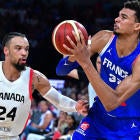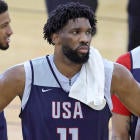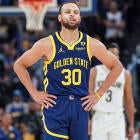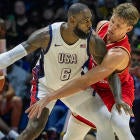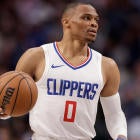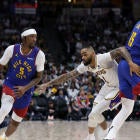
Nine months ago, some of the best teams in the NBA practically sat out the entire 2020 offseason for the promise of future cap space. Luka Doncic nearly toppled the Clippers by himself, but the Mavericks refused to give any free agent more than $4.1 million to support him. The Toronto Raptors sacrificed their entire center rotation in the name of flexibility. The Miami Heat, coming off of a trip to the NBA Finals, let starting power forward Jae Crowder walk for a mid-level offer from the Phoenix Suns. Neither the Heat nor the Raptors gave more than one guaranteed year to a single free agent.
Now let's fast forward to August 2021. What became of that precious cap space? Technically, nothing. None of those three teams functioned below the cap this offseason. Neither did the New Orleans Pelicans, who gave up multiple first-round picks to theoretically create space, or the Bulls, who spent the most total money on external players this offseason. In total, only five teams actually used space: The Knicks, Spurs, Pistons, Hornets and Grizzlies.
Next season, that number could be even lower. On Aug. 15, HoopsHype's Yossi Gozlan projected that seven teams would have cap space next offseason. Since then, four of those teams have cut into that space significantly. Boston extended several players, Charlotte extended Terry Rozier and signed Kelly Oubre, New Orleans re-signed Josh Hart and Detroit acquired and waived DeAndre Jordan. The remaining three all have meaningful players whose possible extensions could and likely will cut into their space as well: Memphis has Jaren Jackson, San Antonio has Lonnie Walker and Orlando has Mo Bamba and Wendell Carter.
There's an important distinction to be made here. The Heat, Mavericks, Raptors, Pelicans, Bulls and several other teams all spent money this offseason. They just didn't spend cap space. The difference in the short term was fairly minimal. Teams were still generally able to acquire the players they targeted, they just used different tools to get them than they previously might have. The long-term ramifications of this approach are harder to predict. Hoarding cap space to pursue significant offseason additions has been a staple of NBA roster-building since the years leading up to 2010's historic free-agent class, but if fewer and fewer teams are prioritizing that space, the ways in which players change teams and get paid are going to change drastically. So let's start with an obvious question: if fewer teams are using cap space nowadays, how are they spending money? For the most part, they operated above the salary cap, which opened up several different avenues to spend. Those included:
Sign and trades
The 2011 CBA changed the rules regarding sign and trades to make them less advantageous for players in response to LeBron James and Chris Bosh getting bigger contracts despite leaving their original teams to join the Miami Heat a year earlier. From 2015 to 2018, only four total players were signed and traded, and two of them made less than the mid-level exception. They came back in vogue in 2019 as a way for capped-out teams to pursue high-level players, with Jimmy Butler (Miami) and D'Angelo Russell (Golden State) joining teams they otherwise couldn't have. This offseason, the seven highest-paid free agents that changed teams were signed and traded, including Kyle Lowry (to Miami) and Devonte' Graham (to New Orleans).
It should be noted that teams can use cap space and still execute a sign-and-trade. The Knicks did so with Evan Fournier, for instance. But sign and trades are available to any team willing to commit to staying below the apron (roughly $6 million above the tax line, the dreaded "hard cap"). Even a capped-out team can add players through this route so long as they can match salary as they would need to in any other trade.
Washington's addition of Spencer Dinwiddie is a notable example on that front, but a more interesting instance of sign and trade maneuvering took place in Chicago. The Bulls had a number of partially guaranteed players that they could have waived in order to carve out space. Instead, they traded one of those players, Tomas Satoransky, to match money in the Lonzo Ball deal and Thaddeus Young to do so for DeMar DeRozan. They never could have created the space necessary to sign both players outright without spamming the stretch provision and leaving themselves with years of dead money on their books. By using sign and trades, the Bulls not only landed both but, as we'll discuss later, were able to use the full mid-level exception to bring in Alex Caruso as well.
The appeal for the trading team is obvious. They get something back for players they would otherwise lose for nothing. Yes, it means taking on some extra salary, but teams have grown more willing to attach meaningful assets to get these deals done. San Antonio got a first-round pick for DeRozan when he clearly was not part of their long-term plans. In years past, with cap space more plentiful, they might not have had the leverage to get that pick, but with so many teams operating above the cap, DeRozan needed the sign and trade to get paid what he wanted.
Contract extensions
Miami (Bam Adebayo) and Toronto (OG Anunoby) cut into their 2021 cap space by extending their young stars early, but rookie extensions have remained fairly steady on balance. Veteran extensions, on the other hand, have exploded since 2017, when the new CBA made four key rule changes to discourage player movement.
- Before 2017, players could only receive a 7.5 percent raise in the first year of an extension. Now, they can receive a 20 percent raise.
- Before 2017, only contracts that lasted four or more years could be extended. Now, three-year deals can be extended.
- Before 2017, deals could only be extended after the third anniversary of the signing. Now, extensions are possible on the second anniversary.
- The 2017 CBA also added the designated veteran extension, better known as the "supermax." This allowed players who hit certain benchmarks to sign for the highest possible max salary, a deal starting at 35 percent of the cap, rather than the mid-tier max salary, which starts at 30 percent of the cap.
This severely limited the pool of players cap space teams could sign. Giannis Antetokounmpo (the target Miami, Dallas and Toronto were saving their money for) and Rudy Gobert were both taken off of the market by supermax extensions. Jrue Holiday and Paul George didn't get the supermax, but the more relaxed veteran extension rules allowed both of them to get deals with their incumbent teams they otherwise would have needed to wait until free agency for. That took them off of the table as well.
A number of valuable players have followed suit this offseason. Julius Randle, Terry Rozier, Clint Capela and Marcus Smart have all signed veteran extensions this offseason. Aaron Gordon is reportedly considering one as well. The fact that they're all signing at once is no coincidence. These decisions are compounding. When a player re-signs with his team, he is filling some of that team's future cap space. Other players see that and recognize that it means that there's one fewer team capable of carving out the space to pay them later. So those players re-sign, and even more teams are without future space, so more players re-sign to avoid entering a market without the space to properly pay them, and so on. The entire purpose of saving cap space is signing players like this. If they aren't available, the value of any remaining cap space declines considerably.
Bird Rights
When a player's contract expires, his original team has some form of Bird Rights on him. Those rights allow that team to go over the salary cap to retain that player. Dallas (Tim Hardaway Jr.), Miami (Duncan Robinson and Victor Oladipo), Toronto (Gary Trent Jr.) and New Orleans (Josh Hart) all used Bird Rights to retain at least one significant player this offseason. These rights come in three forms: Non-Bird Rights, Early Bird Rights and full Bird Rights, and the exact category a player falls into determines just how far above the cap their team is allowed to go to keep that player. When a player has full Bird Rights, their team can give them anything up to the max (provided they aren't hard-capped for some other reason).
The catch is that Bird Rights come with something called a cap hold, which is the amount that a player counts for against the salary cap until he signs a new deal. That number is based on a variety of factors and is somewhat manipulable in specific cases with younger players, but essentially, retaining the right to re-sign your own players costs you cap space that you could be spending on others. That often forces teams into a difficult decision: they can create the space to sign new players outright, but doing so would mean letting go of some or all of their own free agents. Dallas in particular was faced with this choice because Hardaway's enormous $28 million cap hold effectively prevented them from spending space. They decided to keep him, but would have needed to renounce him if they'd wanted to spend space.
Cap exceptions
There are two major forms of exceptions that matter in this instance. The first is the mid-level exception, which is a tool teams can use to sign external free agents above the cap, but the amount that exception is worth is based on a team's unique circumstances. Teams that use cap space only have access to the room mid-level exception, which started at $4.9 million this offseason. Teams that operate above the cap can use the non-taxpayer mid-level exception, which started at $9.5 million this offseason. Dallas (Reggie Bullock) and Miami (P.J. Tucker) both used their non-taxpayer mid-level exceptions to add players they could not have gotten for the cap room version.
The second is trade exceptions. These are generated when teams make trades that aren't balanced from a salary perspective. Say, for instance, a team trades a $10 million player for a $5 million player. The team acquiring the $5 million player gets a $5 million trade exception that it can use to acquire a player or players at or below that salary. But when a team uses cap space, it must renounce all trade exceptions it has accumulated. This has been particularly noteworthy for Oklahoma City. Technically speaking, the Thunder haven't even spent up to the salary floor yet (90 percent of the cap). Yet they have not only avoided officially operating as a cap space team, but by virtue of using their non-taxpayer mid-level exception, are actually hard-capped. The Thunder could choose to operate as a cap space team any time they want, but right now, they've been able to retain a $12.8 million trade exception (from the Trevor Ariza trade with Miami) and a $9.6 million trade exception (from the George Hill trade with Philadelphia) by acting as an above-the-cap team.
The proliferation of sign and trades has made those exceptions nearly as valuable in free agency as space itself. Houston was able to add Daniel Theis on a $36 million deal because of the exception it generated by trading Oladipo at the deadline. Get a big enough trade exception and willing enough trade partner and you can add almost any free agent on the market.

CBS Sports HQ Newsletter
Your Ultimate Guide to Every Day in Sports
We bring sports news that matters to your inbox, to help you stay informed and get a winning edge.
Thanks for signing up!
Keep an eye on your inbox.
Sorry!
There was an error processing your subscription.
So why does this matter?
All of the above has, essentially, been an argument for why teams should no longer work hard to carve out cap space. They've just gotten too good at creatively adding and retaining players without it that committing to doing so has become harder and harder to justify. But even in a contemporary setting, space has intangible applications that power player movement. Take Miami. The Heat didn't actually use cap space this offseason, but that thrifty 2020 offseason meant that they could have, and that afforded them considerable leverage over Toronto. If they'd needed to renounce their own free agents to sign Lowry outright, they could have, and the Raptors knew that. When they had multiple suitors at the trade deadline, they reportedly wanted Duncan Robinson or Tyler Herro in a Lowry trade. Knowing that the alternative in August was losing him for nothing, they settled for Precious Achiuwa and Goran Dragic this time around. The fact that the Heat had cap space is precisely what allowed them not to use it. By getting Lowry in a sign and trade instead, they were able to use that full mid-level exception to nab P.J. Tucker and retain their rights to Robinson and Oladipo.
Now let's examine a similar situation brewing in 2022. Rumors have persistently linked Bradley Beal, a 2022 free agent, to the Celtics because of his friendship with Jayson Tatum. Early in the offseason, Boston refused to give out multi-year deals, suggesting that they planned to hoard enough space to offer him a max contract next offseason. And then, in rapid succession, they extended Smart, Robert Williams and Josh Richardson. They vaporized their own possible cap space.
They likely did it hoping to follow the same path Miami did with Lowry. Signing-and-trading for Beal would allow them to keep a deeper supporting cast around him than pinching pennies for cap space would. Here's the catch: Boston lacks Miami's leverage. The Celtics almost certainly won't have the cap space to sign Beal outright. In fact, as we've covered, it's possible that nobody does. That leaves Beal somewhat compromised. Stars frequently force their teams to trade them to certain teams by threatening to walk for nothing if they don't. Well, where is Beal going to walk to? He might not be able to say "trade me to Boston or I'm signing with X." The Wizards could call his bluff.
This would be an unprecedented outcome this far into the player empowerment era. All-NBA players with multiple years left on their contracts regularly force moves, but suddenly, there are scenarios in which free agent stars struggle to get to their team of choice. Zach LaVine is in the same boat next offseason. We don't know whether or not he'll want to remain with the Bulls, but we can look at a barren cap space landscape and wonder how easily he'd be able to find a better situation without Chicago's cooperation.
The ripple effects here run deeper than the NBA's upper class, though. Think about that cycle of extensions depleting cap space leading to more extensions. If players worth more than the mid-level exception know that only a few teams in a given offseason are going to be capable of offering them market-value deals through space, is market value for their services going to decline? If getting and properly paying those players becomes more reliant on their Bird Rights, do they become more valuable in trades?
In the shorter term, a few teams catching onto these trends and pivoting into extreme hoarding feels almost inevitable. The fewer teams have something, the more valuable it becomes. Even if their competitors don't need cap space, they might need room beneath the hard cap, or merely to save a few bucks under the tax line. Will the price of dumping bad contracts go up?
Again, these are highly unpredictable outcomes. Every trend and rule change leads to unintended consequences, and looming over all of this is the NBA's national television deal, which expires after the 2024-25 season. CNBC's Jabari Young reported in March that the league wants $75 billion in its next deal, more than tripling its current contracts with Disney and Turner. The 2016 offseason already showed us how a drastic cap spike could upend the league's roster-building framework. Without a working idea of what sort of cap smoothing, if any, the NBA and NBPA plan to implement, there's just no way of knowing how much money teams will even have to spend and how they'll be allowed to spend it.
But what has become clear in recent years is that teams are growing significantly less interested in making the sacrifices that are usually necessary to create cap space. They don't want to waste seasons by refusing to give players long-term deals, and agents don't want to let them. They don't want to let their own free agents leave for nothing when they could be kept to support their major additions, and the convergence of all of the factors discussed above means that they no longer have to. If teams no longer need to use cap space to get the best players, they aren't going to invest the time and assets it takes to create that cap space, and if that cap space disappears, the entire player-movement ecosystem as we know it is going to have to adjust.










